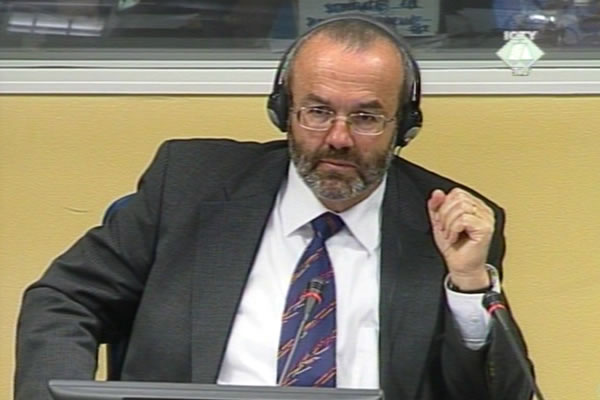Home
‘BRIGANDS’ LOOTED KRAJINA UNHINDERED
Peter Marti, former UN observer in Sector South in Krajina, says he and his colleagues had problems identifying the persons who looted Serb houses after Operation Storm since 'soldiers looked like brigands'. In his opinion, the looting could easily have been stopped regardless of who the perpetrators were
 Peter Marti, witness at the Gotovina, Cermak and Markac trial
Peter Marti, witness at the Gotovina, Cermak and Markac trial Peter Marti from Switzerland gave evidence today at the trial of Croatian generals Ante Gotovina, Ivan Cermak and Mladen Markac. He was a member of the UN observer mission in Sector South in Krajina. His evidence followed a string of Canadian observers and officers who commanded the UN troops. Visiting Krajina villages in August and October 1995 after Operation Storm, Marti got the impression that about 60 percent of the houses were partially or completely destroyed. He did put in a caveat: a number of houses had been destroyed in the period between the summer of 1991 and the summer of 1995, while the Serbs controlled the area.
The looting in Krajina after Operation Storm became a part of everyday life, Marti contends. It looked like some routine 'unpaid job', he said. He saw civilians among the looters and people in military uniforms wearing bandanas; they 'looked more like brigands than regular troops'. Regardless of who the perpetrators were, Marti is sure that the Croatian authorities could have prevented the looting by setting up check points, arresting the perpetrators and punishing them. According to the witness, the fact that the looting went on unhindered for a long period of time shows the Croatian authorities didn’t want to do anything. The looting went on in three stages, the witness explained: first cars and household appliances were taken, then furniture and finally door and window frames. During the 'waves of looting’, as Marti described it, the communication between the UN representatives and the Croatian authorities was unilateral. 'We kept them informed about the situation in the field on our own initiative, but they never addressed us on this issue', the Swiss observer explained.
In the course of Marti's evidence the prosecutor showed a list of 184 Serb civilians killed in Krajina from the beginning of Operation Storm to 29 November 1995. The list was compiled on the basis of a report drafted by the UN political affairs department. Dusan Suica and Milan Marcetic, two Serbs from the village of Gudura in the Gracac municipality are among those listed there. They were killed on 29 September 1995, two days after they met the witness when he visited that part of Krajina.
In the cross-examination, Gotovina's defense counsel showed the witness a criminal report filed on 5 October 1995 by the Zadar police against unidentified persons who killed Suica and Marcetic. Marti was not aware of that, but he assumed that at least 184 criminal reports should have been filed, based on the UN reports. The defense counsel didn't say if this was the case and if any unidentified perpetrators have been identified and brought to justice. The witness agreed with the defense counsel that he and his colleagues had problems identifying the looters. Nobody from the Croatian military or civilian authorities even tried to 'bring at least some order' and prevent the looting, he repeated, agreeing that some UN observer teams didn't keep detailed track of the number of damaged objects, making their assessments without leaving their cars.
Linked Reports
- Case : Gotovina et al. - "Operation Storm"
- 2008-06-09 WITNESS: 'BIG FOOLS' WERE KILLING, NOT SOLDIERS
- 2008-06-06 DEFENSE: CANADIANS FAVOURED KRAJINA SERBS
- 2008-06-05 PREVENTION OF CRIMES ‘ON PAPER’
- 2008-06-12 LIVING PYRE IN THE VILLAGE OF DJURICI
- 2008-06-17 PROSECUTOR: CROATIA HAS NOT DELIVERED OPERATION STORM DOCUMENTS
- 2008-06-23 GALBRAITH: AUTHORITIES ORDERED OR APPROVED CRIMES
